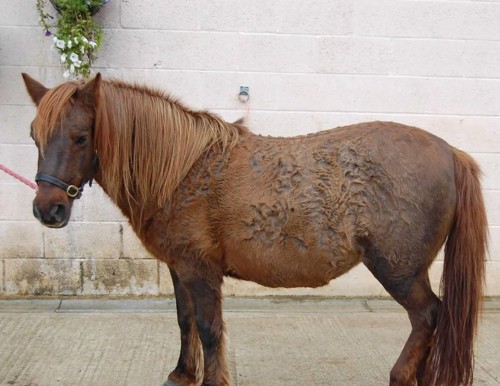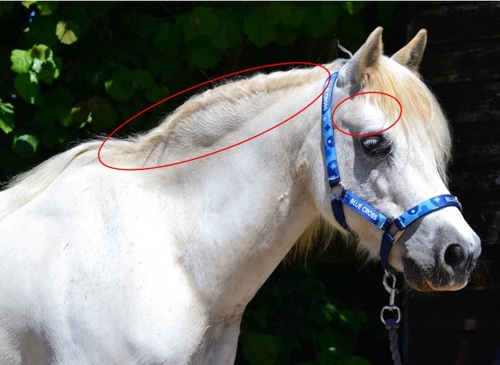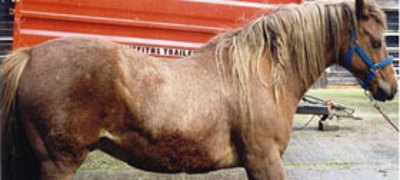What causes PPID?
PPID is caused by changes in the pituitary gland, located at the base of the brain. In a healthy horse, this gland is regulated by a chemical called dopamine, which helps control hormone production. In horses with PPID, the brain doesn’t make enough dopamine, which causes certain hormones1, particularly ACTH (adrenocorticotropic hormone), to rise too high, leading to the signs we often see with the condition2.
PPID can occur in any breed or sex. If you’re caring for a donkey, we recommend visiting The Donkey Sanctuary for tailored advice.

Recognising the signs of PPID
Signs of PPID can vary, some may be more subtle than others. Common signs include:
- Long and/or curly coat
- Difficulty shedding the winter coat
- Sweating that seems unusual (not related to exercise or weather)
- Laminitis
- Drinking and urinating more than usual
- Lethargy or low energy
- Weight loss
- Fatty deposits in unusual places across the body
- Bulging of the hollow above the eyes
- Muscle loss, especially along the topline, back and hindquarters
- Persistent infections (such as sinusitis or dental issues)
- Recurrent hoof abscesses.

Photo credit: The Blue Cross. 
Photo credit: The Blue Cross.
Diagnosing PPID
Identifying PPID early means you can start managing it sooner, helping your horse enjoy a better quality of life.
Speak to your vet if you notice changes in your horse’s behaviour or appearance. They’ll assess your horse’s history and symptoms and may take a blood sample to check ACTH levels. These tests are analysed in a lab and usually take a few days for results.
Tip: If you're travelling to the vet for testing, your horse may need to rest for at least 30 minutes before the sample is taken to avoid inaccurate results3.
You can also visit the Care about Cushing’s website to learn more about testing options and potential cost support.
Managing PPID
While PPID can’t be cured, it can be effectively managed with the right care and treatment. Your vet may recommend medication and regular monitoring to help control hormone levels and reduce symptoms.
Medication
chevron-down
chevron-up
Prascend is a commonly prescribed medication that helps regulate hormone production4. Long-term studies show that many horses respond very well to this treatment. It’s usually given as a tablet so it’s easy to hide in feed but make sure your horse eats it!
A paste version is also available. Though not yet licensed in the UK, it can be prescribed by your vet if needed for welfare reasons (for example, a pony that won’t take a tablet, leading to a decline in their condition)5.
Once started, medication is usually required for the rest of your horse’s life. This ongoing care can be a big financial commitment, so make sure to talk to your vet for further advice and support.
It’s important to stay organised, order refills in advance and monitor your horse’s response, your vet may need to adjust the dose over time6.
Managing symptoms
chevron-down
chevron-up
To help your horse maintain a positive quality of life, you may need to make some adjustments to their care routine:
- Clipping may be needed in warmer months if your horse struggles to shed their coat.
- Use rugs if the weather turns chilly.
- Keep a healthy fat score to help reduce the risk of laminitis.
- Maintain regular dental care and a testing-led deworming plan.
- Stick to a routine farriery schedule.Monitor closely for signs of infection.
Some horses with PPID may also develop insulin resistance, which can be managed similarly to Equine Metabolic Syndrome (EMS). Always follow the advice from your vet.
References
chevron-down
chevron-up
- Rice, J. (2022) Cushing’s disease in horses (PPID). PetMD.
- Care about Cushing’s. (2023) Equine Cushing’s Disease.
- Jacquay, E. T. et al (2025). The impact of short‐term transportation stress on insulin and oral sugar responses in insulin dysregulated and non‐insulin dysregulated horses. Equine Veterinary Journal.
- Liphook Equine Hospital. (2015) Equine Cushing’s Disease.
- Tatum, R. C. et al (2020). Efficacy of pergolide for the management of equine pituitary pars intermedia dysfunction: A systematic review. The Veterinary Journal, 266, 105562.
- Schott, H. et al., (2022) Long-Term Response of Equids with Pituitary Pars Intermedia Dysfunction to Treatment with Pergolide. Proceedings American Association of Equine Practitioners. (68) Pp. 230.



